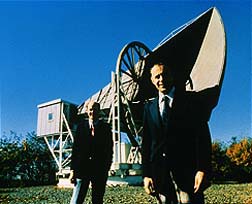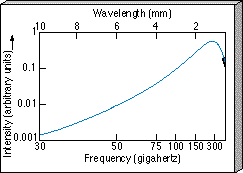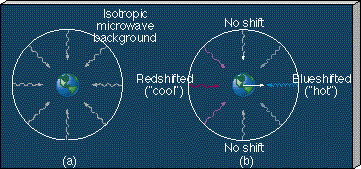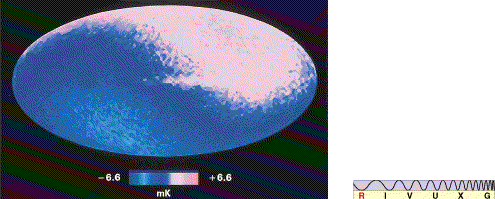Looking out into space is equivalent to looking back into time.
(More Precisely 25-1) But how far back in time can we probe? Is there any way to study the universe beyond the most distant quasar? How close can we come to perceiving directly the edge of time, the very origin of the universe?
A partial answer to these questions was discovered by accident in 1964, during an experiment designed to improve the U.S. telephone system. As part of a project to identify and eliminate interference in satellite communications, Arno Penzias and Robert Wilson, two scientists at Bell Telephone Laboratories in New Jersey, were studying the Milky Way's emission at microwave (radio) wavelengths, using the horn-shaped antenna shown in Figure 26.14. In their data they noticed a bothersome background "hiss" that just would not go away—a little like the background static on an AM radio station. Regardless of where and when they pointed their antenna, the hiss persisted. Never diminishing or intensifying, the weak signal was detectable at any time of the day, any day of the year, apparently filling all space.

Figure 26.14 This "sugarscoop" antenna, originally built to communicate with Earth-orbiting satellites, was used in discovering the 3 K cosmic background radiation. Pictured are Robert Wilson (left) and Arno Penzias, who used the antenna to make the discovery.
What is the source of this radio noise? And why does it appear to come uniformly from all directions, unchanging in time? Unaware that they had detected a signal of great cosmological significance, Penzias and Wilson sought many different origins for the excess emission, including atmospheric storms, ground interference, equipment short circuits—even pigeon droppings inside the antenna! Eventually, after conversations with colleagues at Bell Labs and theorists at nearby Princeton University, the two experimentalists realized that the origin of the mysterious static was nothing less than the fiery creation of the universe itself. The radio hiss that Penzias and Wilson detected is now known as the cosmic microwave background. Their discovery won them the 1978 Nobel Prize in physics.
In fact, researchers had predicted the existence and general properties of the microwave background well before its discovery. As early as the 1940s, physicists had realized that in addition to being extremely dense, the early universe must also have been very hot and that shortly after the Big Bang the universe must have been filled with extremely high energy thermal radiation—gamma rays of very short wavelength. Researchers at Princeton had extended these ideas, reasoning that the frequency of this primordial radiation would have been redshifted from gamma ray, to X-ray, to ultraviolet, eventually all the way into the radio range of the electromagnetic spectrum as the universe expanded and cooled (Figure 26.15). (Sec. 3.4) By the present time, they argued, this redshifted "fossil remnant" of the primeval fireball should have a temperature of no more than a few tens of kelvins—peaking in the microwave part of the spectrum. The Princeton group was in the process of constructing a microwave antenna to search for this radiation when Penzias and Wilson announced their discovery.

Figure 26.15 Theoretically derived blackbody curves for the universe (a) 1 second after the Big Bang, (b) 100,000 years after the Big Bang, (c) 10 million years after the Big Bang, and (d) at present, approximately 10 billion years after the Big Bang.
The Princeton researchers confirmed the existence of the microwave background and estimated its temperature at about 3 K. However, because of atmospheric absorption, this part of the electromagnetic spectrum happens to be difficult to observe from the ground, and it was 25 years before astronomers could demonstrate conclusively that the radiation was described by a blackbody curve. In 1989 the Cosmic Background Explorer (COBE) satellite measured the intensity of the microwave background at wavelengths straddling the peak of the curve, from half a millimeter up to about 10 cm. The results are shown in Figure 26.16. The solid line is the blackbody curve that best fits the COBE data. The near-perfect fit corresponds to a universal temperature of about 2.7 K.

Figure 26.16 The intensity of the cosmic background radiation, as measured by the COBE satellite, agrees very well with that expected from theory. The curve is the best fit to the data, corresponding to a temperature of 2.735K. The experimental errors in this remarkably accurate observation are smaller than the dots representing the data points.
A striking aspect of the cosmic microwave background is its high degree of isotropy. Its intensity is virtually constant (in fact, to about 1 part in 105) from one direction on the sky to another. This isotropy provides strong support for the assumption of the cosmological principle. It also provides us with a novel means of measuring Earth's "true" velocity through space, without reference to any neighboring galaxies or galaxy clusters. If we were precisely at rest with respect to the universal expansion (like the coin taped to the surface of the expanding balloon in Figure 26.5), then we would see the microwave background as almost perfectly isotropic, as illustrated in Figure 26.17(a). However, if we are moving with respect to that frame of reference, as in Figure 26.17(b), then the radiation from in front of us should be slightly blueshifted by our motion, while that from behind should be redshifted.

Figure 26.17 (a) To an observer at rest with respect to the expanding universe, the microwave background appears isotropic. (b) A moving observer measures "hot" blueshifted radiation in one direction (the direction of motion) and "cool" redshifted radiation in the opposite direction.
Thus, to a moving observer, the microwave background should appear a little hotter than average in front and slightly cooler behind. Figure 26.18 shows a COBE map of the microwave background temperature over the entire sky. The blue regions are hotter than average, by about 0.0034 K; the red regions cooler by the same amount. The data indicate that Earth's velocity is about 400 km/s in the approximate direction of the constellation Leo. Even though the principle of relativity says that there is no preferred frame of reference, as the laws of physics look the same to all observers, there is nevertheless a way to determine our absolute velocity with respect to the universe!

Figure 26.18 A COBE map of the microwave sky reveals that the microwave background appears a little hotter in the direction of the constellation Leo and a little cooler in the opposite direction. The maximum temperature deviation from the average is about 0.0034 K, corresponding to a velocity of 400 km/s in the direction of Leo.
When we observe the microwave background, we are looking almost all the way to the very beginning of the universe. The photons that we receive as these radio waves today have not interacted with matter since the universe was a mere 100,000 years old, when, according to our models, it was less than 1/1000 of its present size. To probe further, back to the Big Bang itself, requires us to enter the world of nuclear and particle physics. The Big Bang was the biggest and the most powerful particle accelerator of all! In the next chapter we will see how studies of conditions in the primeval fireball may aid us in understanding the present-day structure and future evolution of the universe in which we live.